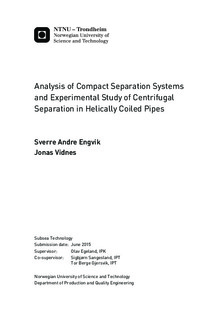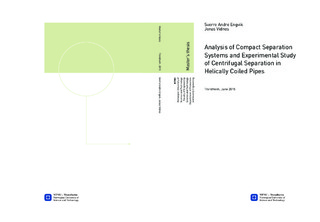| dc.description.abstract | The offshore petroleum industry is experiencing challenges as exploration and production are forced towards remote and deep reservoirs, combined with high cost-efficiency demands. Topside facilities struggle with limited space, and use of subsea processing equipment is increasing. Here, separation systems play an important role and has potential for improvement. Cyclonic separators are often referred to in association with compact separation systems. However, other types of separators have the potential of achieving compact designs.
In order to meet rising challenges in the industry, this project involves an analytical and experimental study, seeking alternative or improved compact separation solutions. To define the state of existing technology, the analysis involved studies of fluid dynamic theory, gravitational and centrifugal separation principles, and "state-of-the-art" separators and concepts. The objective with the experimental study was to investigate separation capabilities for the less common centrifugal principle, namely the helically coiled pipe.
The results of the analytical study implied that most compact systems utilise the centrifugal principle. Factors promoting the helical coil principle were defined. This included a simple pipe structure, excellent pressure-containment abilities, and previous helical coil experiments showed promising phase distributions. However, achieving stable phase distributions to allow separation seemed sensitive to variations in flow rate and coiled pipe geometry.
The experimental study featured an air-water flow in a helically coiled pipe. The flow in the coiled pipe was photographed for a range of air and water flow rates, different numbers of loops, and different curvature radii. Images indicated that above certain air flow rates, the coiled pipe caused transition from stable to unstable phase distribution. Unstable phase distributions were typically recognised as plug or slug flow. The effect of having more than one loop in the coil reduced the air flow rate at which unstable flow developed. The effect of shortening the curvature radii increased the air flow rate that caused unstable flow. In other words, the helical coil achieved best results for short curvature length, either by minimising the number of loops or reducing the curvature radius. These measures indirectly caused a higher flow rate, because shorter curvature length reduces the frictional pressure loss. In addition, shorter curvature radius and higher flow rate increase the centrifugal effects.
A different observation was that despite maintaining a favourable phase distribution throughout the coiled pipe, an instant transition to unstable flow could occur at coil outlet. This indicated that the stable distribution may not sustain downstream of the coil. The level of similitude between the experimental flow and a hypothetical full-scale gas-liquid flow was analysed. The analysis indicated that the experiment could suffer from scale-effects, because viscous- and surface tension forces become significant at small scales.
The experimental study gave indications on separation capabilities, as achievement of stable phase distribution was possible for certain coil configurations and flow rates. However, the narrow operating range, and possible errors in the experiment, brought uncertainties to whether a full-scale helical coil could achieve phase separation. Hence the results in this thesis could neither prove nor disprove the helical coil as a phase separator. More comprehensive research is required to determine the separation capabilities. Recommendations for further work include larger experimental dimensions to reduce scale-effects, and using fluids that improve similarities to hydrocarbon flows. | |

